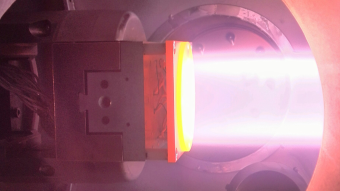Home » About EUROfusion » Consortium Members » Germany
The Max Planck Institute for Plasma Physics (IPP) is one of the largest fusion research centres in Europe, with campus locations in Garching and Greifswald. IPP is an institute of the Max Planck Society and scientifically associated with the Helmholtz Association..
With a workforce of about 1,100, IPP is one of the largest fusion research centres in Europe.
IPP operates the fusion devices ASDEX Upgrade (Garching) and Wendelstein 7-X (Greifswald), and is coordinator of EUROfusion and host to the EUROfusion Programme Management Unit. IPP’s ten scientific divisions investigate the confinement of high-temperature hydrogen plasmas in magnetic fields, heating of plasma, plasma diagnostics, magnetic field technology, data acquisition and processing, plasma control, plasma theory, materials research, and plasma-wall interaction.
The “Axially Symmetric Divertor Experiment” tokamak ASDEX Upgrade is named after the special magnetic field configuration in its divertor. This enables the interaction between the hot fuel and the surrounding walls to be influenced, removing perturbing impurities from the plasma, making sure the vessel walls are safeguarded and attaining good thermal insulation of the core plasma. ASDEX Upgrade is tokamak with the highest heating power density in Europe.
Thanks to their similarlyshaped plasma cross-sections, ASDEX Upgrade and JET form a stepladder to ITER for scaling experiments. Furthermore, ASDEX Upgrade is used for developing scenarios for DEMO.
Wendelstein 7-X is the world’s largest fusion device of the stellarator type. It has modular, superconducting coils that enable steady state plasma operation, and tests optimised magnetic fields for confining plasma.
Wendelstein 7-X began operations in December 2015 and now investigates the suitability of the stellarator concept for use as a power plant. Plasma equilibrium and confinement are expected to be of a quality comparable to that of a tokamak of the same size, but the structure will avoid the disadvantages of a large current flowing in a tokamak plasma. With plasma discharges lasting up to 30 minutes, Wendelstein 7-X is to demonstrate the essential stellarator property of continuous operation. To achieve this, the first wall of the plasma vessel is now completely equipped with pressurized water cooling.
Fusion researchers at FZJ address two key aspects of fusion research – materials for extreme loads and plasma-material interactions, using linear plasma machines on site along with fusion experiments all over the world. In conjunction with theory and model developments, fusion power plant scenarios are predicted.
About 110 researchers, technicians, PhD candidates, post-docs, and scholarship holders are developing and operating devices, simulating and performing experiments in collaboration with numerous partners at universities and research labs.
Researchers at FZJ do research into synergistic effects of particle flux, heat load, and neutron damage on materials. A linear plasma device, PSI-2, enables well-defined experiments applying high particle fluxes and heat loads to material surfaces. Another plasma device, JULE-PSI, and the electron beam facility JUDITH-3 will start operation at the High-temperature Materials Laboratory (HML) allowing investigation of neutron irradiated wall materials and components under operationally relevant loads. New techniques, including laser-based diagnostics and spectroscopy, are developed for in-situ observation.
FZJ is involved in the technological developments of Wendelstein 7-X and ITER with emphasis on methods intended to obtain information on material and plasma conditions during experiments. FZJ is strongly engaged in the development of enabling materials for future fusion reactors. FZJ boasts a strong theory group and access to high-performance supercomputers. Numerical tools developed at FZJ describe the plasma-wall interaction processes bridging various dimensions and phenomena.

The Karlsruhe Institute of Technology (KIT), being “The Research University in the German Helmholtz Association”, is with about 9,800 employees one of the largest research and education institutions in Germany. KIT prepares its 22,300 students for responsible tasks in society, industry, and science by offering research-based study programs.
KIT’s dedicated nuclear fusion programme involves around 190 scientists, engineers, PhD Students and staff working in eight KIT institutes.
The KIT Nuclear Fusion Programme develops key technologies and materials for fusion energy, such as the design, engineering, realisation and testing of components and systems for ITER, developments for DEMO and future fusion power plants, and contributions to Wendelstein 7-X.
KIT has vast expertise in tritium processing and optimization of the fusion reactor fuel cycle and is leading in developing high power gyrotrons and optical transmission systems.
KIT has developed the concept for the European solid breeder blanket and contributed to the EU liquid breeding blanket. KIT researchers lead the EUROfusion Breeding Blanket Work Package.
KIT develops RAFM steels (including EUROFER), studies related joining technologies and develops materials databases as well as refractory alloys. Particular emphasis is on neutron-induced damage and materials qualification.
Home » About EUROfusion » Consortium Members » Germany